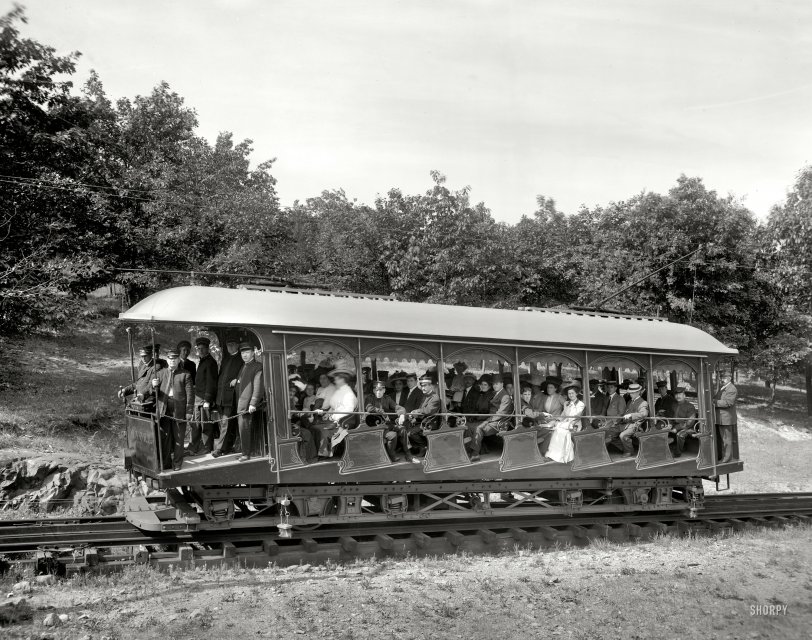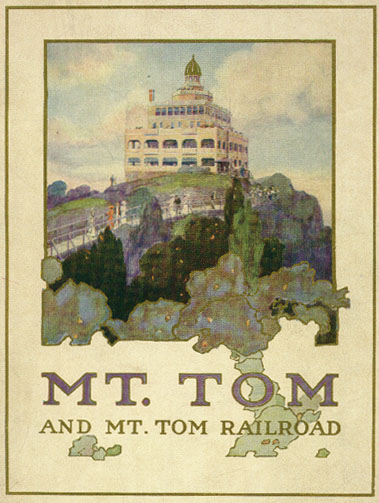


Framed or unframed, desk size to sofa size, printed by us in Arizona and Alabama since 2007. Explore now.
Shorpy is funded by you. Patreon contributors get an ad-free experience.
Learn more.

- Baldwin 62303
- Baldwin VO-1000
- Cold
- No expense spared
- Tough Guys
- Lost in Toyland
- And without gloves
- If I were a blindfolded time traveler
- Smoke Consumer Also Cooks
- Oh that stove!
- Possibly still there?
- What?!?
- $100 Reward
- Freeze Frame
- Texas Flyer wanted
- Just a Year Too Soon
- WWII -- Replacing men with women at the railroad crossing.
- Yes, Icing
- You kids drive me nuts!
- NOT An Easy Job
- I wonder
- Just add window boxes
- Icing Platform?
- Indiana Harbor Belt abides
- Freezing haze
- Corrections (for those who care)
- C&NW at Nelson
- Fallen Flags
- A dangerous job made worse
- Water Stop
Print Emporium
Mt. Tom Railway: 1908

Holyoke, Massachusetts (vicinity), circa 1908. "An elevating car -- Mount Tom Railway." 8x10 inch glass negative, Detroit Publishing Company. View full size.
Safety brake sensor, not self-leveling chain drive
This is an intriguing semi-funicular trolley railway, unique so far as I can find, but there is virtually zero technical decription available of its design from the period, at least on the internet. Including the two Shorpy hi-rez photos there are only about a dozen photos in all, most fuzzy. And not a single photo of the summit's sheave 8 ft diameter unpowered pulley. Contrast that with the Lake George Catskills funicular, of which even the suppliers of each piece of the system are known, and line drawings available.
Yet the two Mt Tom trolleycars themselves are quite spectacular high quality designs for the period to my engineering eyes. They lasted forty years. So who was responsible? For my personal interest's sake, I have figured out how it all worked, which for an old retired mechanical engineer has been quite interesting to say the least. Thanks Shorpy for publishing these two photos in the first place.
The chain drive from the railwheel axle through the bearing journal cover is to a governor shaft/regulator mechanism, not dissimilar to the Lake George arrangement by Otis which preceded this rail line. If the cable breaks, and the car runs away, the regulator senses the overspeed or reversal of rotation and activates the braking jaws on the car to grab the third iron rail and stop the car. Presumably it stops the electric motors as well.
The self-leveling argument for the seats seems to have been invented out of thin air by another blogger and repeated here. The seats themselves can be seen here to be pre-tilted so that they were more level when on the actual incline.
The brushes are the way only the Elizur Holyoke, which always took the left turnout at the bypass facing uphill whether ascending or descending, remained in telephone contact during the bypass phase of the journey. One brush arm is longer than the other to reach the appropriate wire - internal contact method unknown.
Beyond the turnout bypass either up or down, both cars used the two wires to the right of the line facing uphill for telephone contact. And guess what? I cannot find a single photo of the main telephone wire contact system. Nobody seemed to photograph the right-hand side of either car. Ever. Other photos show different attachment arrangements of the brush arms to the EH car, so it must have been troublesome.
No, the two trolleycars are not mirror images of each other either. Very clever indeed.
Some photos from other sources may be found here:
http://leonardjlosholyokehistory.blogspot.ca/2013/02/more-photos-of-holy...
Musical Conductors
I believe there are only two conductors, one driving and one at the back. They have the same type of hats (double braid). The other men in Nero collar jackets appear to be band members possibly arriving for the day's work at the top of the hill.
[I guess they'd be fiddlers, then. - Dave]
Self-Leveling
The gears and chain underneath the car enabled the car to "self-level" based on the underlying terrain such that passengers were always kept sitting upright relative to the slope of the incline, making the ride slightly more comfortable.
The brushes appear to be grounded
Perhaps they're there to discharge static electricity when they reach the platform to avoid shocks?
Uniform of the day
I count SIXTEEN people wearing uniforms, most seem to be conductors.
The brushes
look like they were a local modification, and they are outboard of the rail, so they're not there to clean it. They have a bonding wire running from them up into the car. So I'll make an educated guess and suggest that the car was prone to charging up, and the brushes were to intended to ground it at the carstops, to prevent the passengers from getting a jolt when they got on or off. More intriguing to me is the chain drive from the rear axle to the shaft at the centre of the truck - can't even begin to guess what that was for.
A clean track is a happy track
Anyone have any idea what the brushes are for at both ends of this car?
I Guess I Need to "Brush" up on Locomotion
I can't figure out what purpose the brushes might serve on the bottom of the streetcar. Were they used for electric pickups or were they just for dirty boots? The wires along the top of the rails are also a mystery.
[The lower conductors are telephone wires. - Dave]
Obedience
With the exception of the ghosty lady in the first row of seats, it appears that almost everybody else sat still, looked at the birdy and didn't smile.
The Place to Be
Once Holyoke was the place to be. It had an opera house, literary societies and stunning architecture. Indeed, some of New York's best architects from the early 20th century got their start there. And Mountain Park on Mt. Tom was a very fashionable summer retreat, even President Mckinley went there at least once. Holyoke's paper and silk based economy boomed until the end of the WWII.
Deindustrialization has hit Holyoke hard and the place now has a reputation of being a very rough town. But once it was really at the pinnacle of society in the Northeast.
NOTICE
Anyone smiling will be removed by the conductor(s) immediately.
More than enough
I'm hoping it didn't take eight people to run this wonderful machine up and down the Mount Tom run. And I'd move away from the fellow in the second to last row, he doesn't look too steady, if you get my drift.
Looks like fun
www.mounttom.com for more info on this railway.

























On Shorpy:
Today’s Top 5